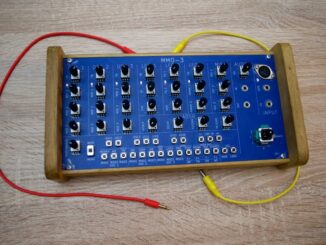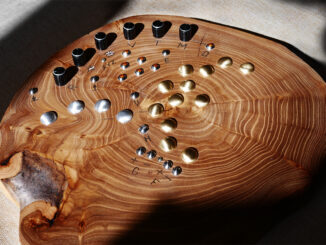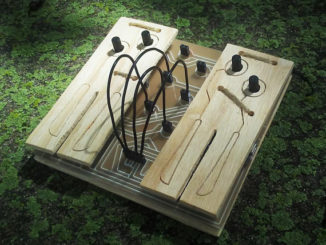Ciat-Lonbarde has partnered with music duo Mouse on Mars to develop Clicker, a new experimental Synthesizer for microsecond orchestras.
Experimental synthesizers stand out because of their unusual concepts, workflows, sounds, or all of the above. Peter Blasser and his Ciat Lonbarde synthesizers have made a name for themselves in this area.
For his latest project, Clicker synth, he teamed up with the electronic duo Mouse on Mars from Berlin. Some also know them from their music app labeling company, MoMinstruments (Elastic Drums, fluXpad…).
Ciat-Lonbarde Clicker
The idea for the Clicker did not come from the developer but from Jan St. Werner from Mouse on Mars:
“I want to create the sound of that moment when a string is activated—not the tone of the vibrating string itself.” These were the words of Jan St. Werner (Mouse on Mars), spoken just a few months ago during a phone conversation with Peter Blasser. “It’s a device that triggers the speaker, creating a spatial response,”
Jan wanted to create his own instrument which he envisioned for his artistic contribution to this year’s Venice Biennale. More precisely, an impulse generator that can be modulated. The Clicker is the result of this brainstorming call.
Technically, the Clicker is a dual-voice Synthesizer with a classic Ciat-Lonbarde interface design. It is also the smallest synth Peter Blasser has developed so far and, I think, also the cheapest.
It offers two trigger inputs (support for Ciat, standard trigger, or Eurorack), two manual trigger buttons, two AD envelope generators, two Ringlers (Rob Hordijk-inspired ring modulator), and a cross-modulation section. A button also switches between two modes: click and music mode with an LED for visual feedback.
Ciat-Lonbarde Clicker has two identical sides on which the respective connectivity is distributed: 2 CV inputs, 1 trigger in, three CV out, and three knobs. The common ground is the black jack top middle with two more knobs underneath it.
Peter said in the Hainbach interview and demo that the synth has an excellent noise floor (“silent floor”).
An Orchestra In A Microsecond
As mentioned initially, the Ciat Lonboarde Clicker is all about clicks or tiny sound moments. Peter said that Clicker followed a very different path compared to other synths.
“Where synth-makers often aim for sustained, lush sounds and expansive forms, the clicker unfolds its magic in the briefest moments imaginable.” And so are the sounds that Clicker generates. They are very short, clicky, and unique. The Clicker can also generate self-triggering patches using feedback.
It works as a standalone interactive instrument and also in combination with other instruments, such as a drum machine or a Eurorack system.
First Impression
It is an extraordinary instrument for special click-sound occasions. I find such instruments very inspiring and exciting because they are refreshingly different from the often classic synth concepts.
Ciat-Lonbarde Clicker is available now for 332€ + VAT from Patch Point.
More information here: Ciat Lonbarde / Patch Point






Be the first to comment